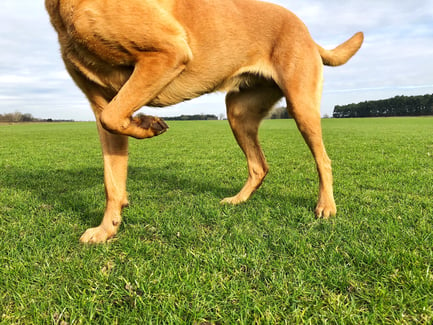Table of Contents
Dogs are an important part of the family, especially when they’ve been your sidekick for many years.
This makes it heartbreaking to watch them ache as time takes its inevitable toll.
An aging dog gradually becomes more susceptible to injuries and painful issues with its joints, muscles, and cartilage. Your once-energetic pooch might also start avoiding strenuous activities they used to love, like playing fetch.
But wipe those tears away. Science has granted you a special power: the ability to “slow” time.
Health supplements (particularly glucosamine) can help combat the signs of dog aging, reduce joint pain, and give your beloved pup a happier, healthier life.
The world of supplements can be overwhelming, though. And full of pitfalls. You’ll need some guidance. Luckily, it’s all right here below.
Just scroll down, and you’ll find out all about:
- Glucosamine
- How it benefits an old dog
- The 6 best joint supplements on the market
Now let’s get cracking (so your dog’s joints don’t have to)!
What Is Glucosamine?
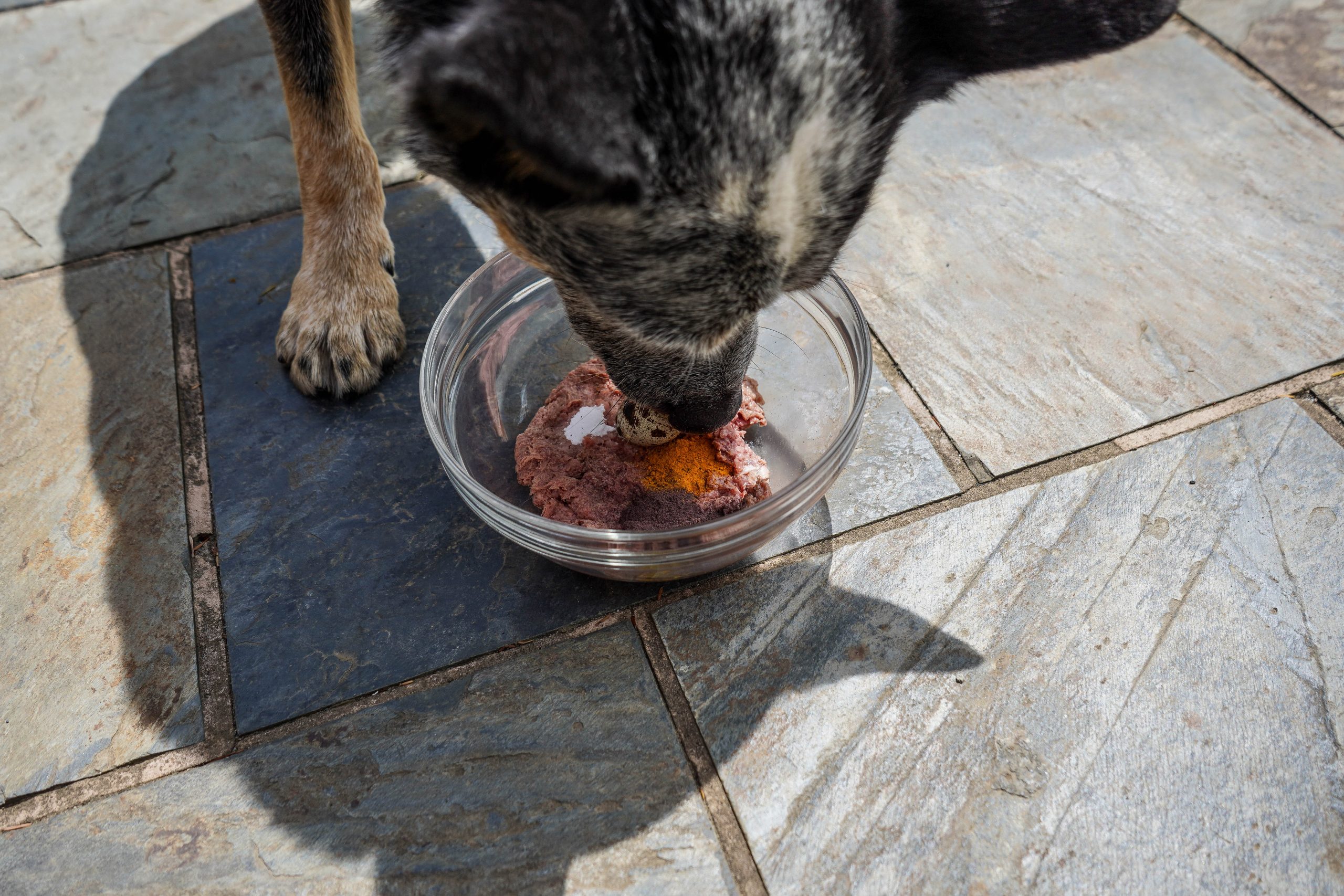
It’s the most important active ingredient in health supplements for senior dogs.
Why?
Because glucosamine helps keep your dog’s joints healthy and pain-free.
It’s particularly significant for breeds genetically prone to having joint and bone problems — Mastiffs, German Shepherds, and Golden Retrievers come to mind immediately.
But it’s not just for doggies. It’s also great for keeping the entire mammal family (including humans, cats, and horses) flexible and active as our joints age.
So, what exactly is it?
Glucosamine Definition
Glucosamine is an essential chemical compound (an amino sugar, to be precise) that’s naturally found in animal cartilage — the fibrous, elastic tissue that cushions joints and protects bones from rubbing against each other.
Most notably, it helps the body complete the following tasks:
- Regenerate and repair cartilage
- Produce synovial fluid (the liquid that reduces friction in joints)
- Provide structure to tissues and bones
Pretty impressive, right?
Definitely, but just one small problem — time.
As we age, our bodies produce less and less glucosamine on their own, and the cartilage in our joints starts to degrade and break down. This puts us at risk of injuries, stiffness, pain, and even lameness. And this where supplements come to the rescue.
They provide cartilage with a much-needed boost of glucosamine, which can help combat aging’s adverse effects and reduce pain and inflammation.
When looking at supplements, you’ll find two major glucosamine types (sulphate and hydrochloride).
Both are beneficial for dogs, but they’re slightly different from one another.
- Glucosamine sulphate contains sulphur and supports collagen production, both important factors in boosting joint health.
- On the other hand, glucosamine hydrochloride is more naturally stable and bioavailable, meaning it’s easier for the body to absorb and put to good use.
These unique advantages explain why using two types of glucosamine in supplements is a smart strategy for getting the best of both worlds.
There are two more things you should know.
One — the names and functions of the other important active ingredients that often appear alongside glucosamine:
- Chondroitin sulphate — used primarily to prevent cartilage breakdown
- Methylsulfonylmethane (MSM) — a potent antioxidant that reduces pain and inflammation
- Hyaluronic acid (H.A.) — ideal for keeping joints flexible and well-lubricated
Two — a small warning about the manufacturing process.
Glucosamine is often harvested from shellfish, so be sure to pick a product that’s been made in a lab if your dog is allergic.
Now that’s enough chemistry and mile-long names, we promise!
Let’s move on and discuss why glucosamine supplements are a good idea for your senior dog.
Why Do Old Dogs Need It?

Since you already know all about glucosamine and its benefits, it’s enough for us to say this.
The natural production of glucosamine in dogs starts to slow down quite early in their lives, from around four or five years old.
This leaves our canine friends with plenty of time to develop joint issues and other unpleasant, painful conditions that can really harm their welfare.
Not pretty.
But don’t just stand by and wait for the inevitable; do something to hinder joint pain!
More specifically:
- Feed your dogs a nutritious diet and keep them at a healthy weight.
- Ensure they get enough exercise (without overdoing it).
- Take them for regular veterinary checkups.
- Add a premium glucosamine supplement to their meal plan.
You could delay adding supplements until you see obvious signs of dog aging and pain, but it’s advisable (and far more effective) to act preventively.
By doing so, you’ll help your aging dog better cope with these potential issues:
| Condition | Symptoms and Warning Signs | Glucosamine’s Positive Effects |
| Aging joints |
|
|
| Injuries |
|
|
| Hip Dysplasia |
|
|
| Arthritis |
|
|
| Overall Health |
|
|
Want more details about glucosamine’s positive impact on an old dog’s health?
Impact on Joint Health
Your old dog’s reduced ability to produce glucosamine means one thing — their joints are a potential weak link. And if you don’t help, their cartilage might start wearing away, and they could easily develop stiffness, swelling, and pain. Which in turn will slow them down and make them a lot less fun to be around.
They might even end up looking like this guy:

Now surely that’s not the puppy you love and remember!
But luckily, glucosamine and its sidekicks (chondroitin, MSM, and H.A.) can help stop this from becoming the new norm.
These active ingredients are the building blocks of healthy joints. They contribute to cartilage regeneration, synovial fluid production, and lower levels of inflammation and pain.
Stronger joints should get your puppy off the sofa and back to their usual selves chasing down tennis balls, mailmen, and, of course, the neighbour’s cats.
If John happens to complain about your dog’s newfound speed, make it up to him by recommending a bit of glucosamine for his cats, too.
They’ll need it to stay nimble!
Impact on Injury

Each and every dog is at risk of injury, no matter how canine-friendly your house is. All it takes is an icy driveway or a careless jump off the couch.
Common issues include dislocations, sprained ligaments, strained tendons, and broken bones.
Glucosamine is great for these unfortunate situations because it can help your dog recover by reducing inflammation and promoting strong joint and bone health.
But don’t forget to visit your vet, as serious injuries might require prescription meds or surgery.
P.S. If your dog is anything like this energy ball, then definitely consider glucosamine supplements as a preventive measure for reducing the likelihood and severity of injuries!

Impact on Hip Disease
Hip dysplasia in dogs is a serious problem that affects over 15% of the canine population.
Odds are that sooner or later, you’ll be face to face with it, especially if you love large or giant dog breeds.
Here’s what you need to know to be prepared:
Hip dysplasia is a degenerative, hereditary disease that causes laxity in the ligaments of the hip joint. This, in turn, causes the affected joint to pop in and out, leading to swelling, pain, and potentially arthritis if left untreated.
You’ll likely notice this issue when your dog starts walking strangely (“bunny hopping” or “wobbly hind end”) or struggles with certain movements (like jumping in your car).
Vets will generally recommend surgery or non-surgical options like hip braces, medicine (NSAIDs), or physical therapy to manage the condition.
In either case, adding glucosamine, chondroitin, MSM, and H.A. to their diet is a wise choice.
The extra nutrients are manna for their joints both post-surgery and as part of a disease management plan.
Impact on Arthritis
Arthritis, also known as a degenerative joint disease (DJD), is another painful condition you need to be wary of. Both for yourself and your dogs.
Research has shown that about 25% of dogs are diagnosed with this disease during their lifetimes and that a whopping 60% show radiographic evidence of it.
It’s not something to be taken lightly.
But what exactly is it? What symptoms should you look out for? And can glucosamine help?
Arthritis is an incurable illness characterized by the progressive deterioration of cartilage, connective tissue, and bones in the joints.
It’s usually extremely painful and can lead to swelling, stiffness, and lameness.
You’ll detect all of these things in your senior dog if they’re affected, plus an overall unwillingness to be active and play like they used to.
Luckily, glucosamine can help alleviate your dog’s discomfort, slow down the disease, and improve their lives.
Just remember that it’s more effective when combined with other anti-arthritis activities like:
- Eating a healthy diet
- Exercising often but gently
- Sleeping on an orthopedic bed
Impact on Overall Health

Lastly, glucosamine has the potential to help your dog have a happier, more active life.
And this is absolutely pivotal for canines because they’re the personification of a happy-go-lucky creature that loves exercising, playing, and living life to the fullest.
Above all, if they’re a sport dog and their passion is also their job!
Joint pain and difficulties with moving can cause depression, aggressive behaviour, and obesity.
The last thing you want is your ageing pooch turning into a grumpy old man, like this little guy:
We can only hope that his sore owner is considering more exercise and some glucosamine supplements.
Common Glucosamine for Aging Dogs FAQs
“How Do You Keep an Old Dog Healthy?”
As soon as you notice the first dog ageing signs, you should step up your care routine. Your dog’s body will thank you for it.
Try things like:
- Making a low-impact exercise plan
- Monitoring their body weight
- Feeding them a diet indicated for senior dogs
- Elevating food and water bowls
- Getting them a firm orthopedic bed
- Setting up doggy steps and stairs
- Visiting the vet regularly
- Giving them premium glucosamine supplements
“Is Glucosamine Safe for Dogs?”
Yes, glucosamine is safe for dogs of all ages.
However, double or triple-check that you’re buying a high-quality glucosamine supplement that’s been specifically formulated for pets.
This will minimize the risk of side effects and maximize the product’s effectiveness.
What should you look for?
- 0% filler and 100% active ingredients
- Therapeutic dosages
- Two forms of glucosamine: sulfate and hydrochloride
- Added chondroitin, MSM, and hyaluronic acid
- A stamp of approval from a respected health authority
“How and When Will I Know That My Aging Dogs Need Glucosamine?”
You’ll know when you start seeing dog ageing signs — the next question will cover these symptoms in detail.
But it’s generally a best practice not to wait for these signs and start your dog on a preventive cure as soon as possible.
This strategy gives them the strongest chance of having strong joints well into old age.
“What Signs of Dog Aging Should I Look Out For?”
Keep an eye out for these warning bells:
- Stiff joints
- Loss of mobility
- Limping or lameness
- Unwillingness to exercise and play
- Muscle loss
- Obvious signs of pain or aggressive behaviour
- Weight gain
- Excessive licking of joints
If you observe any of these, speak to your vet about starting your ageing dog on a maximum strength glucosamine supplement like Integricare’s TRI-ACTA H.A.
“How Much Glucosamine Does a Senior Dog Need?”
Dogs need about 200–1500 mg of glucosamine per day.
The exact dose depends on their weight, the supplement, and the severity of their condition.
It’s best to check on your supplement’s label for serving sizes or contact your vet if you have any questions.
Let’s show you the correct dosage for TRI-ACTA H.A. for Pets as an example.
| Weight | Dosage |
| Under 10 lb (4.5 kg) | 0.5 g powder (231 mg glucosamine) |
| 10–35 lb (4.5–16 kg) | 1 g (462 mg) |
| 35–75 lb (16–35 kg) | 2 g (924 mg) |
| 75–100 lb (35–50 kg) | 3 g (1386 mg) |
“Can I Give Too Much Glucosamine and Chondroitin to My Older Dog?”
Yes. But the good news is that glucosamine and chondroitin have very few side effects, none of which are lasting. The worst that can happen is a temporary case of diarrhea, nausea, and/or vomiting.
That still doesn’t sound pleasant, though, and plus, it’ll require an extra trip to the vet. So do your senior dog a favour and never feed them more than the recommended dosage!
“Can I Give My Dog My Own Human Glucosamine, Chondroitin, or MSM?”
Absolutely not! Supplements made for humans aren’t suited for dogs because they could contain allergens or toxic ingredients (like xylitol).
So don’t risk it and stick to products made for dogs BY humans.
The Top 5 Joint Supplements for Senior Dogs

It’s time to talk about products.
And since pet supplements aren’t all the same, you need to be careful when picking one for your beloved old dog.
The only downside is that it can take ages to do the proper research. There are tons of joint and mobility animal supplements out there to browse and evaluate. But don’t panic, we’re here to help!
We’ve already done the painstaking job of picking out the 6 top products for you.
So just read through our list, and order the one that tickles your fancy!
Evaluation Criteria — How We Picked Our Favorites
- Quality of active ingredients
- Price-value ratio
- Health benefits
- Sustainable manufacturing
- Valid licenses and approvals from respected authorities
- Potential side effects (if any)
- Customer service and sales support
Ranking At a Glance + Dosage Requirements
| Ranking | Supplement | Daily Dosage |
| 1 | Integricare | TRI-ACTA H.A | 0.5 – 3 g |
| 2 | The Anxious Pet | Organic Hemp Oil | 0.25 – 5 mL |
| 3 | Zesty Paws | Mobility Bites | 1 – 3 tablets |
| 4 | YuMOVE | PLUS for Dogs | 1 – 4 tablets |
| 5 | Pawlabs | G-Max Joint Support | ½ – 2 tablets |
1. Integricare | TRI-ACTA H.A
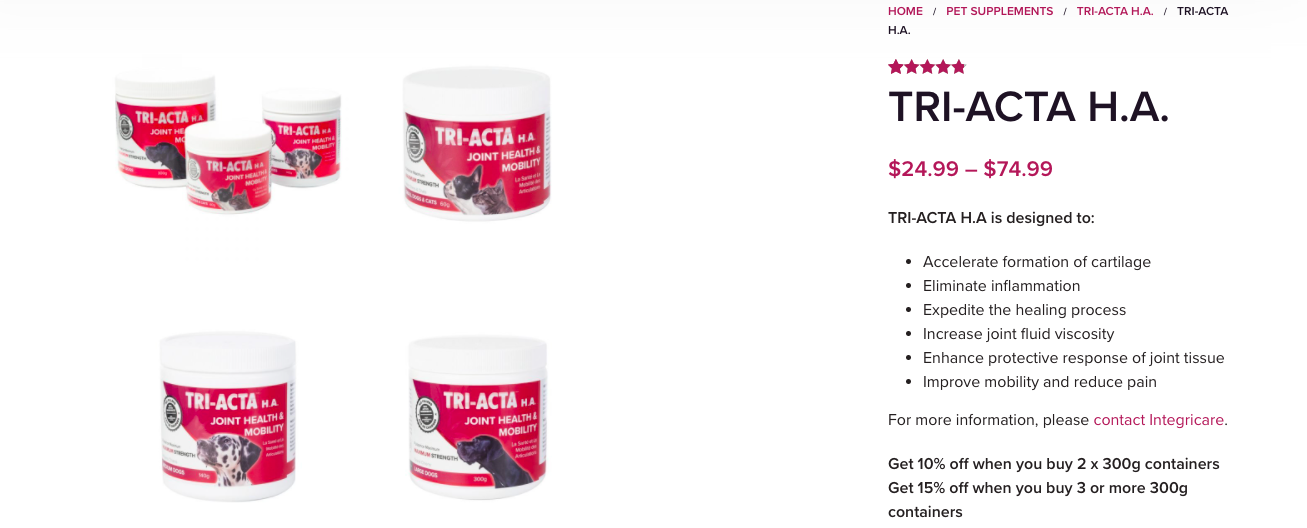
Hey, isn’t that your product?? Yes, it is!
But we didn’t rank it first because it’s ours. Well, not just because it’s ours!
We genuinely believe that we’re manufacturing the best joint supplements for old dogs out there, and we’ll prove it with some cold, hard facts.
- Animal lovers from all over Canada and the USA have trusted us since 1999.
- Our TRI-ACTA products are made with 100% active ingredients, leaving absolutely no space for fillers, useless junk, and unnecessary vitamins.
- We include two types of glucosamine (sulphate and hydrochloride) and hyaluronic acid for maximum efficiency.
- Our products are easy-to-serve powders with tiny serving sizes, making them suited for even the pickiest eaters.
- We use only pharmaceutical-grade ingredients.
- Our supplements are regulated and approved by Health Canada as Low-Risk Veterinary Health Products. You can’t get any safer than that!
Ready to give us a try? Awesome — visit a pet specialty retailer near you or check out our online shop. Read our clients’ rave reviews by clicking here!
Price: $24.99–74.99 on 17th April 2021
2. The Anxious Pet | Organic Hemp Oil
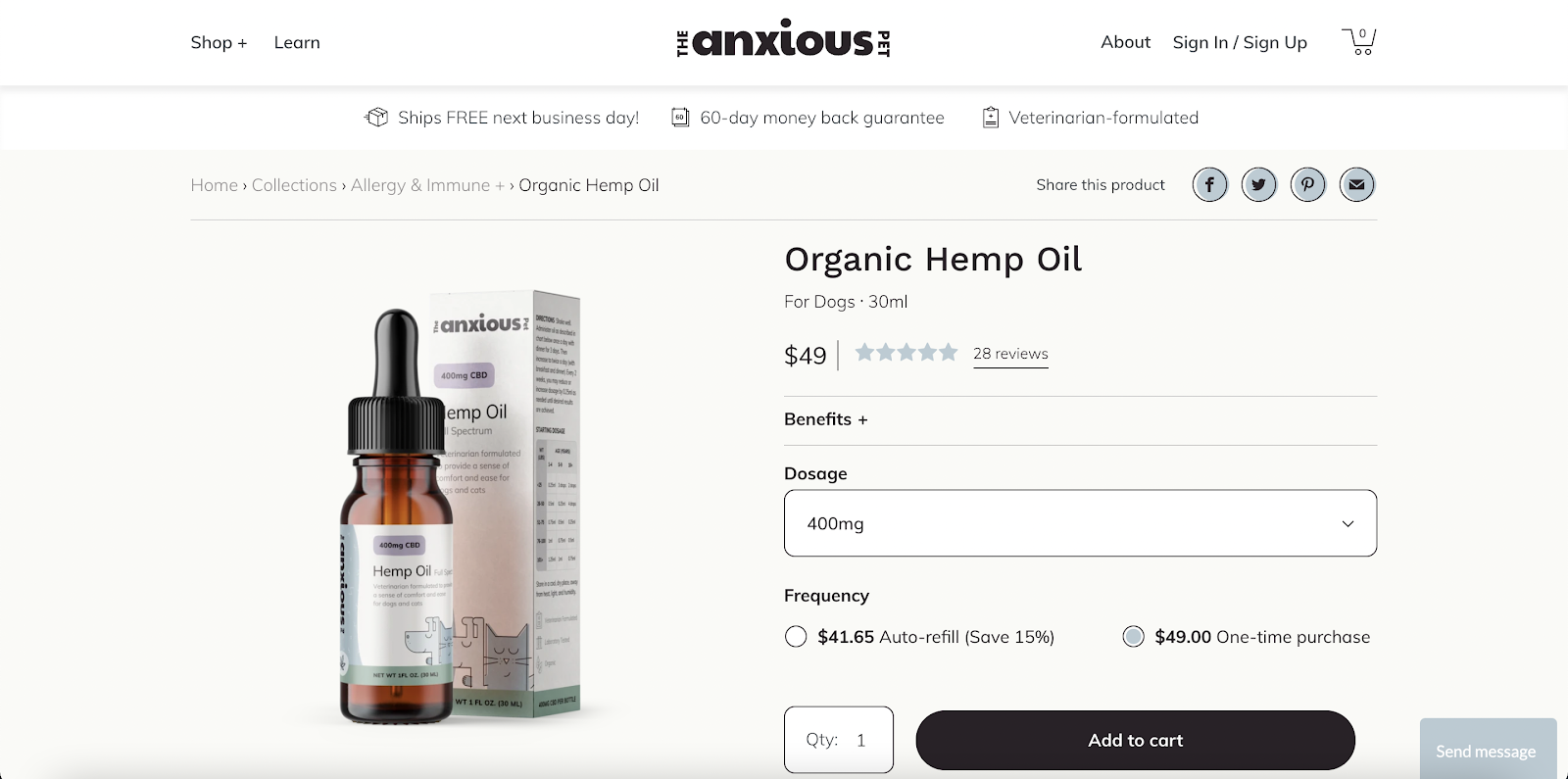
Taking home the silver medal is The Anxious Pet’s Organic Hemp Oil.
This is a unique joint supplement because of its ingredients, full-spectrum cannabinoid oil, and organic fractionated coconut oil.
This makes it a 100% natural remedy that has a host of healing benefits for your pet that:
- Reduces inflammation and pain
- Increases appetite
- Supports the brain and the immune system
- Relieves nausea, anxiety, stress, and allergies
It’s an excellent product backed by research and lab tests, BUT it doesn’t contain glucosamine and chondroitin.
This means it’s great for pain relief and overall health, but not for preventively regenerating and repairing cartilage and synovial fluid.
Price: $49–79 on 17th April 2021
3. Zesty Paws | Mobility Bites
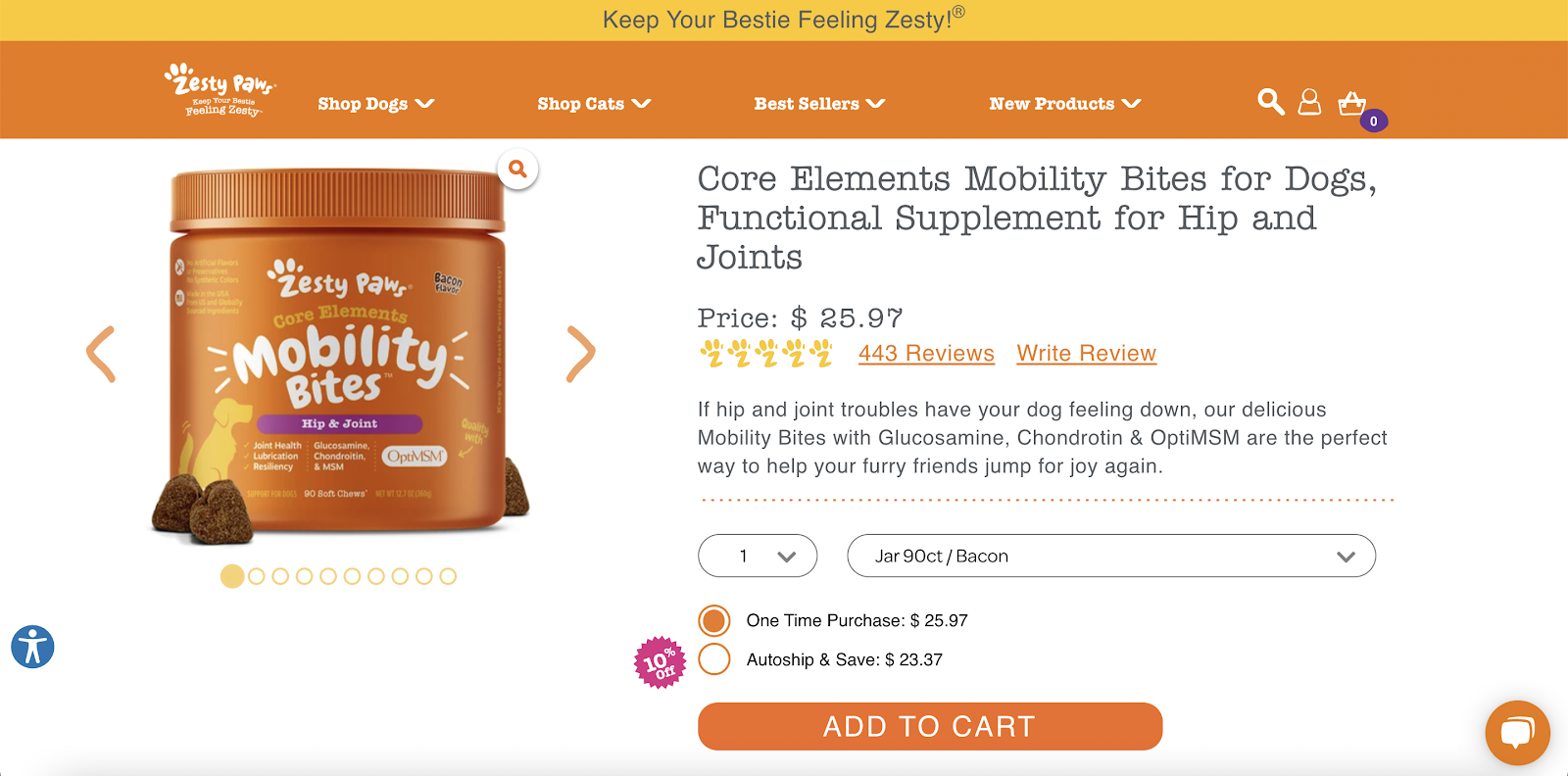
Zesty Paws Mobility Bites are affordable, easy-to-give, and packed with the proper levels of vital ingredients like glucosamine, MSM, and chondroitin.
So why did they miss out on a top 3 finish? Too many filler ingredients.
To make these soft chews stick together and taste delicious, the folks at Zesty ended up adding way too many extra ingredients.
Things like garbanzo flour, pea flour, and coconut glycerin might sound fancy and not be harmful to dogs, but they’re really not necessary. Your dog could do without them!
Price: $25.97 on 17th April 2021
4. YuMOVE | PLUS for Dogs
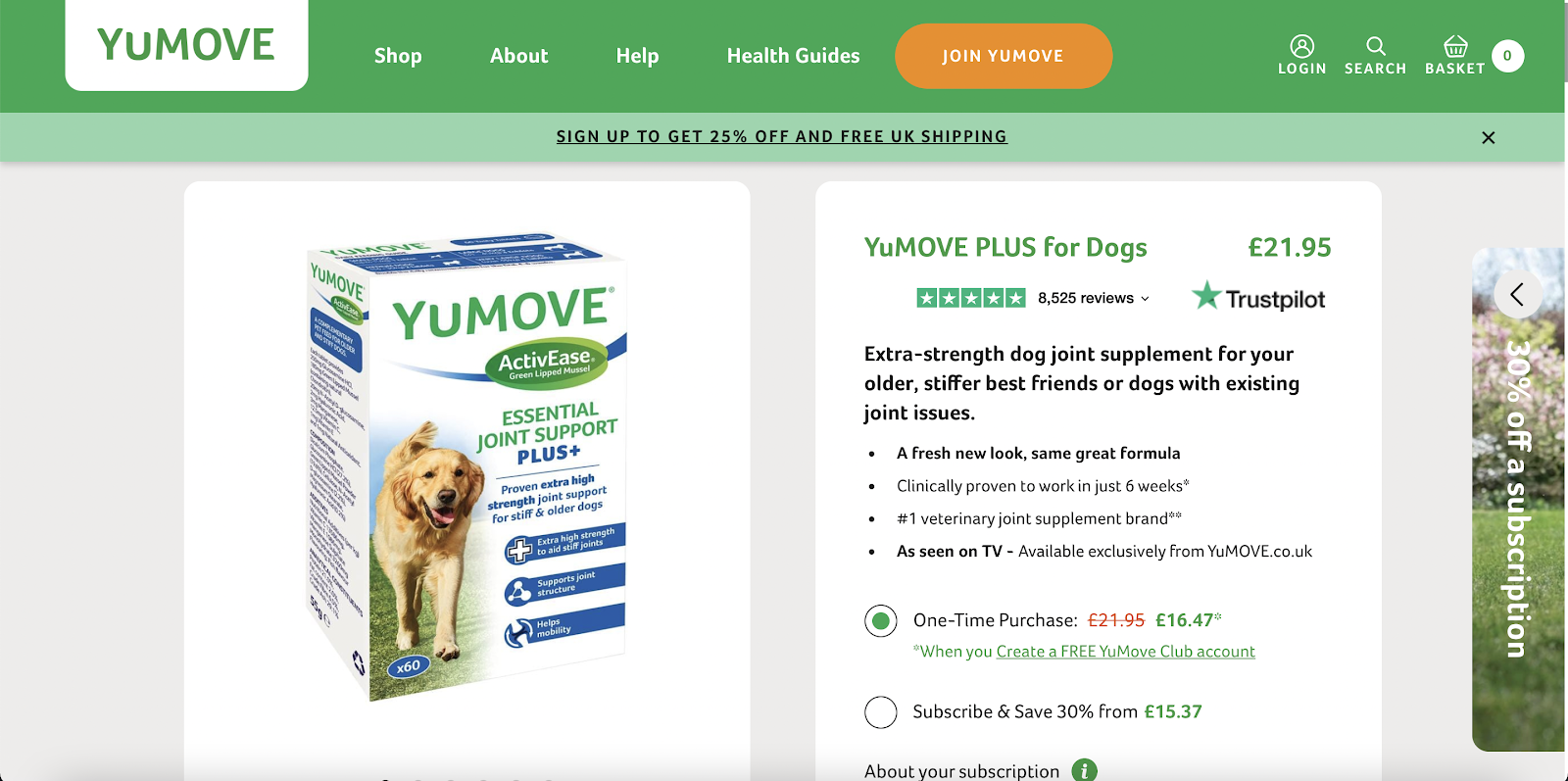
YuMove PLUS for Dogs is one of the UK’s most popular supplements for old dogs, and it has a lot of happy customers.
It’s easy to see why.
This product is made from impressive ingredients, and YuMove is a fantastic company that cares deeply about healthy animals and happy pet owners.
The only real downside is that this supplement contains a smaller quantity of active ingredients than the top four products on this list.
This is because these tablets also contain green-lipped mussels, which take up space usually reserved for the four musketeers of joint health.
These mollusks aren’t a pharmaceutical-grade ingredient, but at least they’ll boost your dog’s overall health thanks to Omega-3 fatty acids.
Price: $30.00 (converted from GBP) on 17th April 2021
5. Pawlabs | G-Max Joint Support
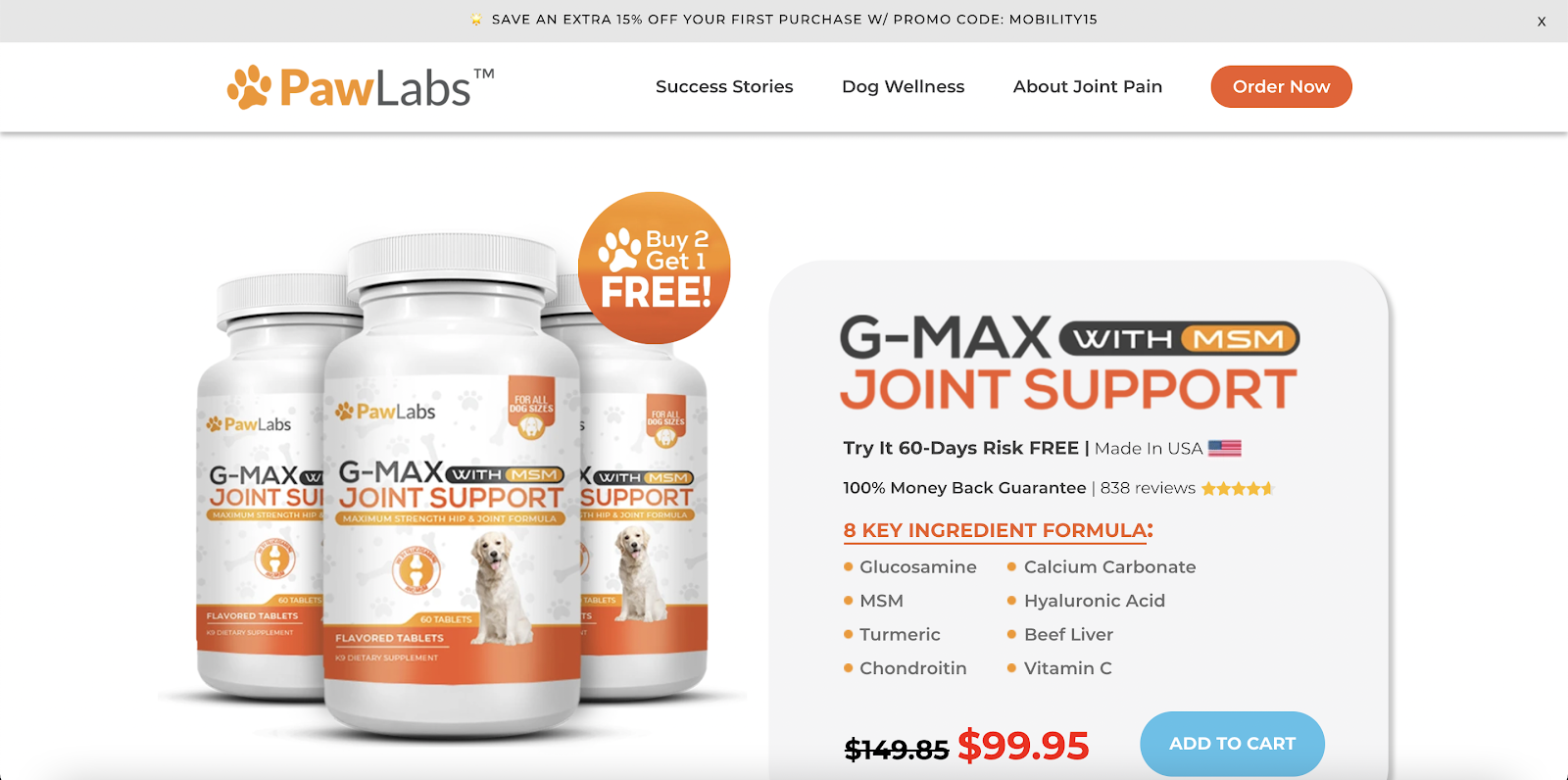
Last up is Pawlabs’ G-Max Joint Support.
This supplement is delicious (bacon flavoured) and has an impressive list of five active ingredients, including all the key ones.
However, the small amount of each critical ingredient leaves something to be desired. Two tablets only contain 250 mg of glucosamine, 100 mg of chondroitin, and 100 mg of MSM.
You can use these preventively, but you’ll need a stronger punch if your ageing dog is suffering from an existing condition.
Price: $49.95–149.85 on 17th April 2021
Summary: Get Started With Glucosamine Supplements for Old Dogs
By this point in the post, we can confidently say that you have a solid understanding of glucosamine, its many benefits, and why it’s an essential supplement for ageing dogs.
Welcome to the light side of the force!
You’re ready to help your old dog live a fuller, more active life.
Here’s how:
- Decide which product from our top six is your favourite.
- Order it today.
- Give it to your dog (reading the dosage recommendation) once you get it.
It’s that simple. We’ll be absolutely honoured if you decide to order our TRI-ACTA H.A. for Pets and give us the chance to help your pet’s joints stay flexible and healthy! We promise you won’t regret it.
If you have any other questions about anything glucosamine or joint health-related, drop us a note and we’ll be happy to help.
Until then, thanks for reading!
Newsletter Signup
Subscribe to our newsletter to receive the latest news and exclusive offers.
.jpg?height=2000&name=Cliick_Integricare-DISPLAY-REVISEDV2%20(1).jpg)
Proactive & Therapeutic Joint Supplements
When given daily, Integricare joint supplements recover bone and joint injuries faster and help prevent mobility injuries from happening in the first place.








